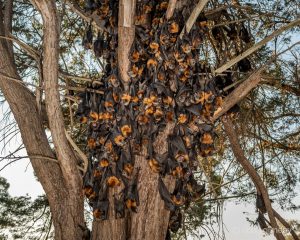Increasingly severe and more frequent weather events
 Climate change is an undeniable fact. In Australia we are seeing the effects of climate change with more frequent and severe droughts, heat waves and devastating fires. This is dramatically changing the Australian landscape and biodiversity.
Climate change is an undeniable fact. In Australia we are seeing the effects of climate change with more frequent and severe droughts, heat waves and devastating fires. This is dramatically changing the Australian landscape and biodiversity.
Flying-foxes are often referred to as the canary in the coal mine and in the last few years Australia has seen mass casualties as thousands drop from trees during intense heat waves and starvation events. These apocalyptic events are brought about by the change in climate which is resulting in longer and more intense heat waves and longer droughts that impact the flying-foxes’ natural food source as native plants are not flowering and producing pollen.
The following is a list of mass death in the last 15 years.
- January 2020: thousands of flying-fox babies died in a heat wave across the Sydney region (estimated numbers still being calculated).
- November 2019 to January 2020: several thousand grey-headed flying-fox babies died in a heat wave in Adelaide (estimated numbers still being calculated).
- December 2019: 4,500 grey-headed flying-foxes (15% of one camp population) died in a heat wave in Melbourne.
- End of winter 2019: severe food shortage resulting in mass deaths of black and grey-headed juvenile flying-foxes in South East Qld.
- November 2018: 33,000 to 40,000 spectacled flying-foxes (a third of the spectacled population) and black flying-foxes died in a heat wave in Far North Qld pushing the spectacled flying-foxes onto the endangered list.
- November 2018: mass casualties in Rockhampton and Townsville due to a heat wave. Adult casualties unknown, approximately 600 babies died.
- November 2014: 7,000 grey-headed and black flying-foxes died in a heat wave at Casino and Richmond Valley in NSW.
- January 2014: an estimated 100,000 grey-headed and black flying-foxes across more than 25 camps died in a heat wave in South East Qld.
- 2013: mass deaths due to starvation event in South East Qld (exact numbers unknown).
- 2010: mass deaths due to starvation event in South East Qld (exact numbers unknown).
- 2007: mass deaths due to starvation event in South East Qld (exact numbers unknown).
- December 2006 to January 2007: 207 grey-headed flying-foxes died in a Melbourne heat wave.
- January 2006: 4273 to 4843 grey-headed flying-foxes across 6 camps died during a heat wave in Victoria and NSW.
For further information on heat events:
Journal article on climate change and the effects of temperature extremes on Australian flying-foxes:
https://www.ncbi.nlm.nih.gov/pmc/articles/PMC2596826/
National Geographic’s 2019 coverage of mass deaths of Flying-foxes:
https://www.nationalgeographic.com/animals/2020/01/flying-foxes-are-dying-en-masse-in-australias-extreme-heat/
How you can help:
Plant native flowering trees for bats, birds and bees in your backyard. Click here to download a list of bat friendly trees.
During droughts and starvation events assist flying-foxes by providing water and food. Click here to download how to build a bat feeding station. Please note that these should only be used in times of need as we do not want the flying-foxes to become reliant on human support, please follow us on Facebook to be informed about food shortages and starvation events.


